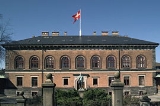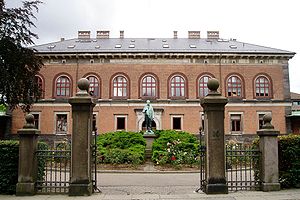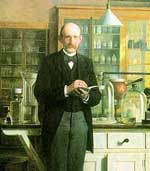
Johan Kjeldahl
Encyclopedia
Johan Gustav Christoffer Thorsager Kjeldahl (1849–1900), was a Danish
chemist
who developed a method for determining the amount of nitrogen
in certain organic compound
s using a laboratory technique
which was named the Kjeldahl method
after him.
at the Carlsberg Laboratory
, associated with Carlsberg Brewery, where he was head of the Chemistry department from 1876 to 1900.
 He was given the job to determine the amount of protein in the grain
He was given the job to determine the amount of protein in the grain
used in the malt
industry. Less protein
meant more beer
. Kjeldahl found the answer was in developing a technique to determine nitrogen with accuracy but existing methods in analytical chemistry
related to proteins and biochemistry
at the time were far from accurate.
and a back titration. He found that ammonium salts can be produced by the reaction between organic compound
s and sulfuric acid
; this step is a digestion
. Ammonium salts produced from this step were collected and, in a second process, reacted with lye
. The ammonia produced in this step was distilled and dissolved in a standardized solution of hydrochloric acid
or sulfuric acid
. Finally, this solution was back titrated with caustic soda to indirectly measure nitrogen.
During the 1880s, Kjeldahl used potassium sulfate
to raise the boiling point of the acid and mercury
as a catalyst to speed the decomposition. For the back titration process of the released ammonia, he used boric acid
buffer solution
.
On 7 March 1883, Kjeldahl presented his method at the Danish Chemical Society.

, Denmark
at the age of 50.
His laboratory technique for nitrogen and protein analysis is still the universally accepted method for this analysis. Although other methods claim to be faster and more efficient, none can cope with the variety of sizes or conditions of samples than Johan Kjeldahl's original method. Kjeldahl equipment is used extensively all over the world.
Denmark
Denmark is a Scandinavian country in Northern Europe. The countries of Denmark and Greenland, as well as the Faroe Islands, constitute the Kingdom of Denmark . It is the southernmost of the Nordic countries, southwest of Sweden and south of Norway, and bordered to the south by Germany. Denmark...
chemist
Chemistry
Chemistry is the science of matter, especially its chemical reactions, but also its composition, structure and properties. Chemistry is concerned with atoms and their interactions with other atoms, and particularly with the properties of chemical bonds....
who developed a method for determining the amount of nitrogen
Nitrogen
Nitrogen is a chemical element that has the symbol N, atomic number of 7 and atomic mass 14.00674 u. Elemental nitrogen is a colorless, odorless, tasteless, and mostly inert diatomic gas at standard conditions, constituting 78.08% by volume of Earth's atmosphere...
in certain organic compound
Organic compound
An organic compound is any member of a large class of gaseous, liquid, or solid chemical compounds whose molecules contain carbon. For historical reasons discussed below, a few types of carbon-containing compounds such as carbides, carbonates, simple oxides of carbon, and cyanides, as well as the...
s using a laboratory technique
Analytical chemistry
Analytical chemistry is the study of the separation, identification, and quantification of the chemical components of natural and artificial materials. Qualitative analysis gives an indication of the identity of the chemical species in the sample and quantitative analysis determines the amount of...
which was named the Kjeldahl method
Kjeldahl method
The Kjeldahl method or Kjeldahl digestion in analytical chemistry is a method for the quantitative determination of nitrogen in chemical substances developed by Johan Kjeldahl in 1883.- Method :...
after him.
Professional life
Kjeldahl worked in CopenhagenCopenhagen
Copenhagen is the capital and largest city of Denmark, with an urban population of 1,199,224 and a metropolitan population of 1,930,260 . With the completion of the transnational Øresund Bridge in 2000, Copenhagen has become the centre of the increasingly integrating Øresund Region...
at the Carlsberg Laboratory
Carlsberg Laboratory
The Carlsberg Laboratory in Copenhagen, Denmark was created in 1875 by J. C. Jacobsen, the founder of the Carlsberg brewery, for the sake of advancing biochemical knowledge, especially relating to brewing. It featured a Department of Chemistry and a Department of Physiology...
, associated with Carlsberg Brewery, where he was head of the Chemistry department from 1876 to 1900.

Cereal
Cereals are grasses cultivated for the edible components of their grain , composed of the endosperm, germ, and bran...
used in the malt
Malt
Malt is germinated cereal grains that have been dried in a process known as "malting". The grains are made to germinate by soaking in water, and are then halted from germinating further by drying with hot air...
industry. Less protein
Protein
Proteins are biochemical compounds consisting of one or more polypeptides typically folded into a globular or fibrous form, facilitating a biological function. A polypeptide is a single linear polymer chain of amino acids bonded together by peptide bonds between the carboxyl and amino groups of...
meant more beer
Beer
Beer is the world's most widely consumed andprobably oldest alcoholic beverage; it is the third most popular drink overall, after water and tea. It is produced by the brewing and fermentation of sugars, mainly derived from malted cereal grains, most commonly malted barley and malted wheat...
. Kjeldahl found the answer was in developing a technique to determine nitrogen with accuracy but existing methods in analytical chemistry
Analytical chemistry
Analytical chemistry is the study of the separation, identification, and quantification of the chemical components of natural and artificial materials. Qualitative analysis gives an indication of the identity of the chemical species in the sample and quantitative analysis determines the amount of...
related to proteins and biochemistry
Biochemistry
Biochemistry, sometimes called biological chemistry, is the study of chemical processes in living organisms, including, but not limited to, living matter. Biochemistry governs all living organisms and living processes...
at the time were far from accurate.
Kjeldahl method
In order to solve the problem of determining accurate nitrogen content in a sample, Kjeldahl developed a method which involves a two-step reaction: a distillationDistillation
Distillation is a method of separating mixtures based on differences in volatilities of components in a boiling liquid mixture. Distillation is a unit operation, or a physical separation process, and not a chemical reaction....
and a back titration. He found that ammonium salts can be produced by the reaction between organic compound
Organic compound
An organic compound is any member of a large class of gaseous, liquid, or solid chemical compounds whose molecules contain carbon. For historical reasons discussed below, a few types of carbon-containing compounds such as carbides, carbonates, simple oxides of carbon, and cyanides, as well as the...
s and sulfuric acid
Sulfuric acid
Sulfuric acid is a strong mineral acid with the molecular formula . Its historical name is oil of vitriol. Pure sulfuric acid is a highly corrosive, colorless, viscous liquid. The salts of sulfuric acid are called sulfates...
; this step is a digestion
Digestion
Digestion is the mechanical and chemical breakdown of food into smaller components that are more easily absorbed into a blood stream, for instance. Digestion is a form of catabolism: a breakdown of large food molecules to smaller ones....
. Ammonium salts produced from this step were collected and, in a second process, reacted with lye
Lye
Lye is a corrosive alkaline substance, commonly sodium hydroxide or historically potassium hydroxide . Previously, lye was among the many different alkalis leached from hardwood ashes...
. The ammonia produced in this step was distilled and dissolved in a standardized solution of hydrochloric acid
Hydrochloric acid
Hydrochloric acid is a solution of hydrogen chloride in water, that is a highly corrosive, strong mineral acid with many industrial uses. It is found naturally in gastric acid....
or sulfuric acid
Sulfuric acid
Sulfuric acid is a strong mineral acid with the molecular formula . Its historical name is oil of vitriol. Pure sulfuric acid is a highly corrosive, colorless, viscous liquid. The salts of sulfuric acid are called sulfates...
. Finally, this solution was back titrated with caustic soda to indirectly measure nitrogen.
During the 1880s, Kjeldahl used potassium sulfate
Potassium sulfate
Potassium sulfate is a non-flammable white crystalline salt which is soluble in water...
to raise the boiling point of the acid and mercury
Mercury (element)
Mercury is a chemical element with the symbol Hg and atomic number 80. It is also known as quicksilver or hydrargyrum...
as a catalyst to speed the decomposition. For the back titration process of the released ammonia, he used boric acid
Boric acid
Boric acid, also called hydrogen borate or boracic acid or orthoboric acid or acidum boricum, is a weak acid of boron often used as an antiseptic, insecticide, flame retardant, as a neutron absorber, and as a precursor of other chemical compounds. It exists in the form of colorless crystals or a...
buffer solution
Buffer solution
A buffer solution is an aqueous solution consisting of a mixture of a weak acid and its conjugate base or a weak base and its conjugate acid. It has the property that the pH of the solution changes very little when a small amount of strong acid or base is added to it. Buffer solutions are used as a...
.
On 7 March 1883, Kjeldahl presented his method at the Danish Chemical Society.

Legacy
Johan Kjeldahl died on 18 July 1900 in TisvildelejeTisvildeleje
Tisvildeleje is the village and coastal part or of the area known as Tisvilde located in on the north coast of the island Zealand in Denmark 60 km/40miles north of Copenhagen in the municipal of Helsinge....
, Denmark
Denmark
Denmark is a Scandinavian country in Northern Europe. The countries of Denmark and Greenland, as well as the Faroe Islands, constitute the Kingdom of Denmark . It is the southernmost of the Nordic countries, southwest of Sweden and south of Norway, and bordered to the south by Germany. Denmark...
at the age of 50.
His laboratory technique for nitrogen and protein analysis is still the universally accepted method for this analysis. Although other methods claim to be faster and more efficient, none can cope with the variety of sizes or conditions of samples than Johan Kjeldahl's original method. Kjeldahl equipment is used extensively all over the world.
Literature
- Jessen-Hansen, H. (1932) Johan Kjeldahl, pp. 169–172 in: Meisen, V. Prominent Danish Scientists through the Ages. University Library of Copenhagen 450th Anniversary. Levin & Munksgaard, Copenhagen.

